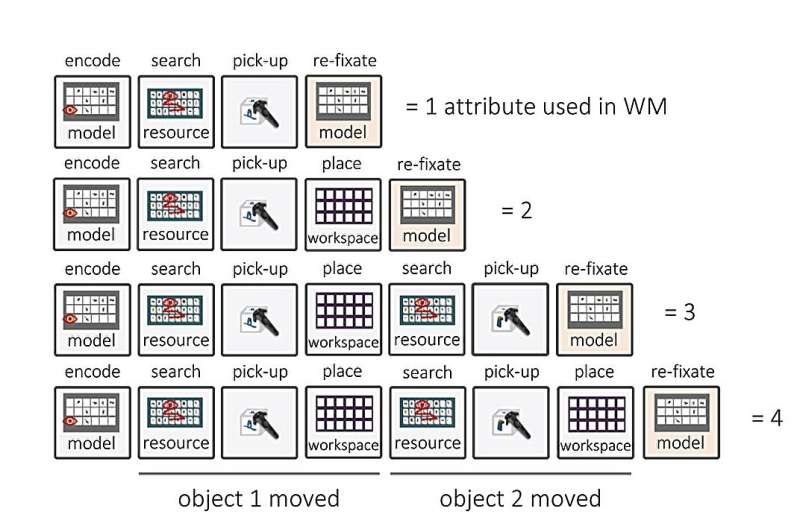
Trade-off between relying on WM and gathering information from the outside world. a Our implicit metric for working memory (WM) usage: copying each object requires its identity and location (attribute) information to be retained in memory. Counting successful retrievals (i.e., identity attribute used) and placements (i.e., location attribute used) between model fixations provided a measure of the number of attributes used in WM. b Average number of attributes used in MW in the two movement effort conditions as a function of distraction, c distribution of attributes used in MW (%). Error bars represent standard error of the mean (N = 30). Rows display data for individual participants. N indicates the number of overall sequences included in the analysis. The symbols *, **, and *** in the figure indicate statistical significance with p-values less than 0.05, 0.01, and 0.001, respectively. Credit: Kumle et al. (Communication Psychology, 2024, Springer’s Nature).
Humans are naturally well-equipped to perform procedural tasks, such as following a recipe and assembling furniture. However, when completing these tasks, people may sometimes encounter visual distractions, such as irrelevant ingredients in the same cupboard as those listed in a recipe.
Ignoring these distractions, focusing on relevant objects, and completing a task successfully is generally easy for humans, but their presence can still affect how tasks are accomplished. Exploring the potential effects of visual distractions during prolonged tasks in experimental settings has thus far proven challenging.
Researchers from the University of Oxford and Goethe University Frankfurt recently set out to study these effects using virtual reality (VR) technology. Their findings, published in Communication psychologysuggest that visual distraction has certain consequences, including slowing people’s movements when completing tasks and forcing them to perform more actions.
“Visual distraction is a pervasive aspect of daily life,” wrote Levi Kumle, Melissa LH Võ and their colleagues in their paper. “However, studying the consequences of distraction during prolonged tasks is not feasible with traditional methods. We developed a virtual reality approach that segments complex behavior into cognitive subcomponents, including cognitive encoding, visual search, working memory use, and decision making.”
Kumle, Võ and their colleagues recruited 30 participants and asked them to take part in two experimental trials, spaced about a week apart. During these trials, participants were asked to perform a task in VR, wearing an HTC Vive Tobii Pro VR headset and an HTC Vive controller.
Participants navigated two different virtual environments, called the instruction room and the testing room. After confirming that they could effectively use the VR equipment in the instruction room, they were able to move to the test room, where they completed a simple task.
This task involved selecting 8 target objects from a resource pool containing 24 objects, some of which were task-irrelevant and therefore visual distractions. On a display model, participants could see the target objects they were supposed to select and how they were supposed to arrange them in a workspace.
Their task was to reproduce the configuration of the objects displayed on the screen by retrieving objects from the resource pool and placing them on the workstation, all within a limited period of time. The researchers changed the location of the model display and the opacity of objects in the resource pool (i.e., making them harder or easier to identify), to determine whether this affected the performance of the participants in the task.
“Participants copied a display pattern by selecting objects from a pool of resources and placing them in a workspace,” the researchers explained. “By manipulating the distraction of objects in the resource pool, we discovered interfering effects of distraction on different cognitive subcomponents.”
Interestingly, the researchers found that visual distractions affected the study participants’ sensory and mnemonic decisions. This affected their ability to coordinate their working memory and encode information while trying to complete the task, which manifested itself as their actions slowing down and performing more costly body movements.
“We successfully traced the consequences of distraction from overall task execution to the decision-making processes that control memory use,” the team said. “Distraction slowed behavior and increased costly body movements. Critically, distraction increased encoding demands, slowed visual search, and decreased reliance on working memory.”
Overall, the results suggest that visual distractions when humans perform natural goal-directed behaviors do not necessarily prevent them from achieving a goal, but they nonetheless have cascading consequences, slowing their movements and increasing effort. necessary to accomplish a task. In addition to shedding new light on the effects of visual distractions, their study highlights the potential of using VR paradigms to conduct psychological and behavioral experiments.
More information:
Levi Kumle et al, Multifaceted consequences of visual distraction during natural behavior, Communication psychology (2024). DOI: 10.1038/s44271-024-00099-0
© 2024 Science X Network
Quote: Probing the effects of visual distraction during natural behavior using VR technology (June 13, 2024) retrieved June 14, 2024 from https://medicalxpress.com/news/2024-06-probing-effects -visual-distraction-natural.html
This document is subject to copyright. Apart from fair use for private study or research purposes, no part may be reproduced without written permission. The content is provided for information only.